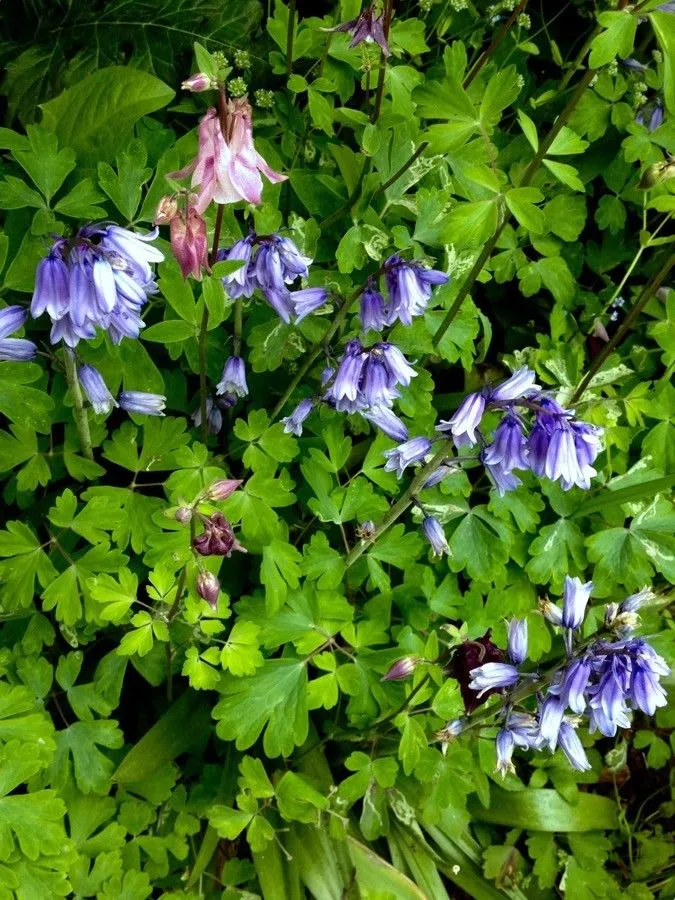
Author: (L.) Chouard ex Rothm.
Bibliography: Feddes Repert. Spec. Nov. Regni Veg. 53: 14 (1944)
Year: 1944
Status: accepted
Rank: species
Genus: Hyacinthoides
Vegetable: False
Observations: W. Europe to NW. Portugal
Wood-hyacinth, known scientifically as Hyacinthoides non-scripta, is a captivating plant native to Western Europe, extending its range to the northwest region of Portugal. A proud member of the Asparagaceae family, this plant is renowned for its striking blue flowers, which often blanket woodlands with a vibrant carpet of color during the spring months.
The Wood-hyacinth typically thrives in shaded, deciduous woodlands where it forms dense colonies. Its enchanting flowers are bell-shaped and pendulous, with a delicate, sweet fragrance that is especially noticeable during the early morning or late afternoon. The blossoms are usually a deep, purplish-blue hue, though pink and white variations are occasionally encountered.
The leaves of Hyacinthoides non-scripta are long, narrow, and strap-shaped, forming a basal rosette from which the flower stalks emerge. These leaves provide an excellent contrast to the colorful flowers, enhancing the overall aesthetic appeal of the plant.
Wood-hyacinth’s bloom time is typically between April and June, making it a herald of spring. This period of flowering coincides with the opening of woodland canopies, allowing the flowers to receive the light necessary for their vibrant display before the canopy closes over for summer.
While the Wood-hyacinth is primarily found in its natural habitat across Western Europe, it has also become a popular choice for ornamental gardening. It is appreciated not only for its beauty but also for its ability to naturalize easily in garden settings, often spreading to form extensive, colorful colonies.
The species was first described in the scientific literature in 1944, as noted in the publication “Feddes Repertorium Specierum Novarum Regni Vegetabilis”. The classification was conducted by Chouard and later refined by Rothmaler, denoted by the author citation “(L.) Chouard ex Rothm.”
These plants are integral to their ecosystems, supporting not just the visual allure of spring but also providing nectar for early pollinators. Conservation efforts are essential for preserving these native populations, especially in the face of habitat destruction and competition from non-native species such as the Spanish bluebell (Hyacinthoides hispanica).
In conclusion, the Wood-hyacinth (Hyacinthoides non-scripta) stands out as a botanical gem of Western Europe. Its delicate, arching blue flowers and the gentle fragrance are delightful heralds of spring, marking a season of renewal and beauty in the natural world.
Dan: almindelig klokkeskilla, klokke-skilla
Deu: eigentliches hasenglöckchen, hasenglöckchen, atlantisches hasenglöckchen
Eng: english bluebell, bluebell, harebell, wood-hyacinth, wild hyacinth
Swe: engelsk klockhyacint
Nob: klokkeblåstjerne
Nno: klokkeblåstjerne
Nld: wilde hyacint
Cym: clychau’r gog
Gla: lus nan coinnlean gorma, lusan nan coinnlean gorma
En: Wood-hyacinth, English bluebell, Bluebell, Harebell, Common Bluebell, Wild Hyacinth
Ar: صفير غير سكريبتا
Zh: 蓝铃花
Kw: Bleujen an gog
Co: Endymion non-scriptus
Cs: Hyacintovec britský
Da: Almindelig Klokkeskilla, Klokke-skilla
Nl: Wilde hyacint, Hazeklokje, Hazenklokje
Eo: Arbarhiacinto
Fi: Englanninsinililja
Fr: Jacinthe des bois, Jacinthe sauvage, Scille penchée, Endymion penché, Jacinthe non décrite
De: Atlantisches Hasenglöckchen, Eigentliches Hasenglöckchen, Hasenglöckchen, Echtes Hasenglöckchen, Englische-Hyacinthe, Gewöhnliches Hasenglöckchen, Hasenblaustern
Ga: Coinnle corra
It: Giacinto a fiori penduli
Ml: ഹയാസിന്തോയിഡ്സ് നോൺ-സ്ക്രിപ്റ്റ
No: Klokkeblåstjerne
Nb: Klokkeblåstjerne
Nn: Klokkeblåstjerne
Gd: Lus nan coinnlean gorma, Lusan nan coinnlean gorma
Sv: Engelsk klockhyacint
Cy: Clychau’r Gog
Fy: Wylde hyasint
© copyright of the Board of Trustees of the Royal Botanic Gardens, Kew.
© copyright of the Board of Trustees of the Royal Botanic Gardens, Kew.
© copyright of the Board of Trustees of the Royal Botanic Gardens, Kew.
Taken Jun 29, 2019 by Dieter Wagner (cc-by-sa)
Taken Apr 20, 2018 by Susana López (cc-by-sa)
Taken May 16, 2019 by Dieter Wagner (cc-by-sa)
Taken Jun 29, 2019 by Dieter Wagner (cc-by-sa)
Taken May 16, 2019 by Dieter Wagner (cc-by-sa)
Taken Apr 22, 2022 by Gaël Covain (cc-by-sa)
Taken Apr 21, 2021 by Dieter Wagner (cc-by-sa)
Taken Mar 26, 2022 by Gaël Covain (cc-by-sa)
Taken Mar 10, 2020 by Al Norton (cc-by-sa)
Taken Jun 29, 2019 by Dieter Wagner (cc-by-sa)
Taken Mar 26, 2020 by CocoRouen (cc-by-sa)
Taken Dec 24, 2020 by Dieter Wagner (cc-by-sa)
Taken Apr 9, 2022 by Gaël Covain (cc-by-sa)
Taken Apr 22, 2022 by Gaël Covain (cc-by-sa)
Taken Mar 26, 2022 by Gaël Covain (cc-by-sa)
Taken Jun 19, 2016 by Tela Botanica − Liliane ROUBAUDI (cc-by-sa)
Taken Jul 14, 2019 by steve prior (cc-by-sa)
Taken Apr 27, 2021 by valerie leclercq (cc-by-sa)
Taken Apr 27, 2021 by Bernard Meyzie (cc-by-sa)
Taken May 24, 2021 by Jorge Iglesias (cc-by-sa)
Taken Apr 18, 2022 by Dave Flack (cc-by-sa)
Taken Apr 9, 2020 by Jean-Pierre Bartkowiak (cc-by-sa)
Taken May 25, 2021 by Werner Köster (cc-by-sa)
Taken May 5, 2021 by Gerrit van der Horst (cc-by-sa)
Taken Apr 16, 2022 by Lucile Hubas (cc-by-sa)
Taken Jun 17, 2018 by arisamiura (cc-by-sa)
Taken Apr 3, 2021 by Brigitte Escobar (cc-by-sa)
Taken Apr 24, 2021 by francois tissot (cc-by-sa)
Taken Apr 10, 2022 by Pierre LEON (cc-by-sa)
Taken May 26, 2022 by Pierre LEON (cc-by-sa)
Growth habit: Forb/herb
Ph maximum: 5.5
Ph minimum: 5.0
Light: 4
Atmospheric humidity: 5
Bloom months: [‘apr’, ‘may’, ‘jun’]
Soil nutriments: 3
Family: Myrtaceae Author: (F.Muell.) K.D.Hill & L.A.S.Johnson Bibliography: Telopea 6: 402 (1995) Year: 1995 Status:…
Family: Rubiaceae Author: Pierre ex A.Froehner Bibliography: Notizbl. Bot. Gart. Berlin-Dahlem 1: 237 (1897) Year:…
Family: Sapindaceae Author: Koidz. Bibliography: J. Coll. Sci. Imp. Univ. Tokyo 32(1): 38 (1911) Year:…
Family: Asteraceae Author: A.Gray Bibliography: Pacif. Railr. Rep.: 107 (1857) Year: 1857 Status: accepted Rank:…
Family: Fabaceae Author: Medik. Bibliography: Vorles. Churpfälz. Phys.-Ökon. Ges. 2: 398 (1787) Year: 1787 Status:…
Family: Aspleniaceae Author: (Cav.) Alston Bibliography: Bull. Misc. Inform. Kew 1932: 309 (1932) Year: 1932…